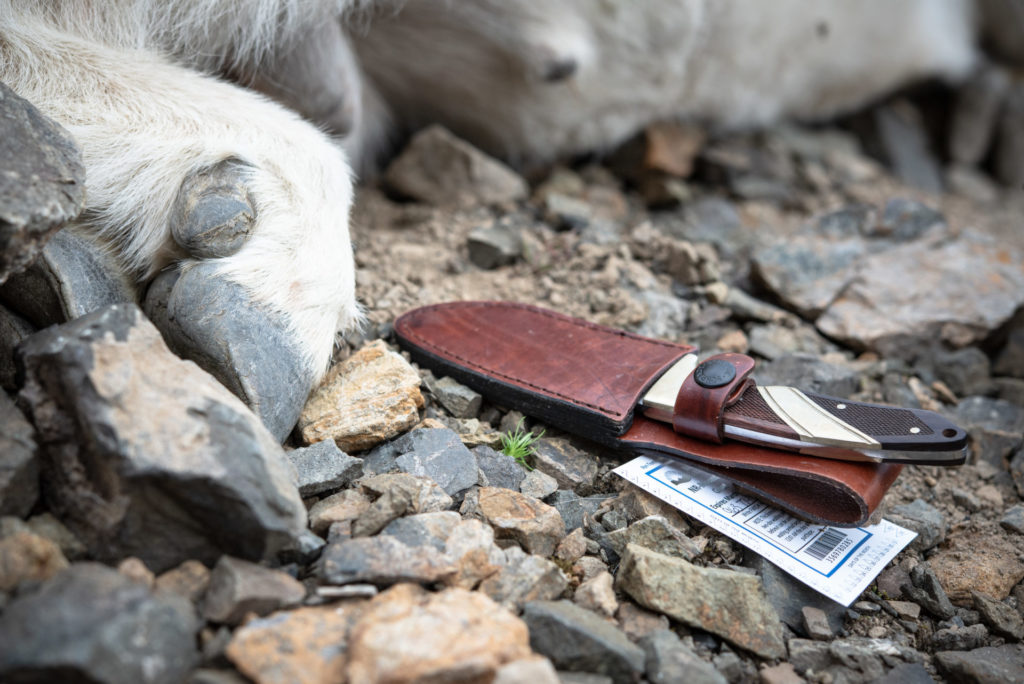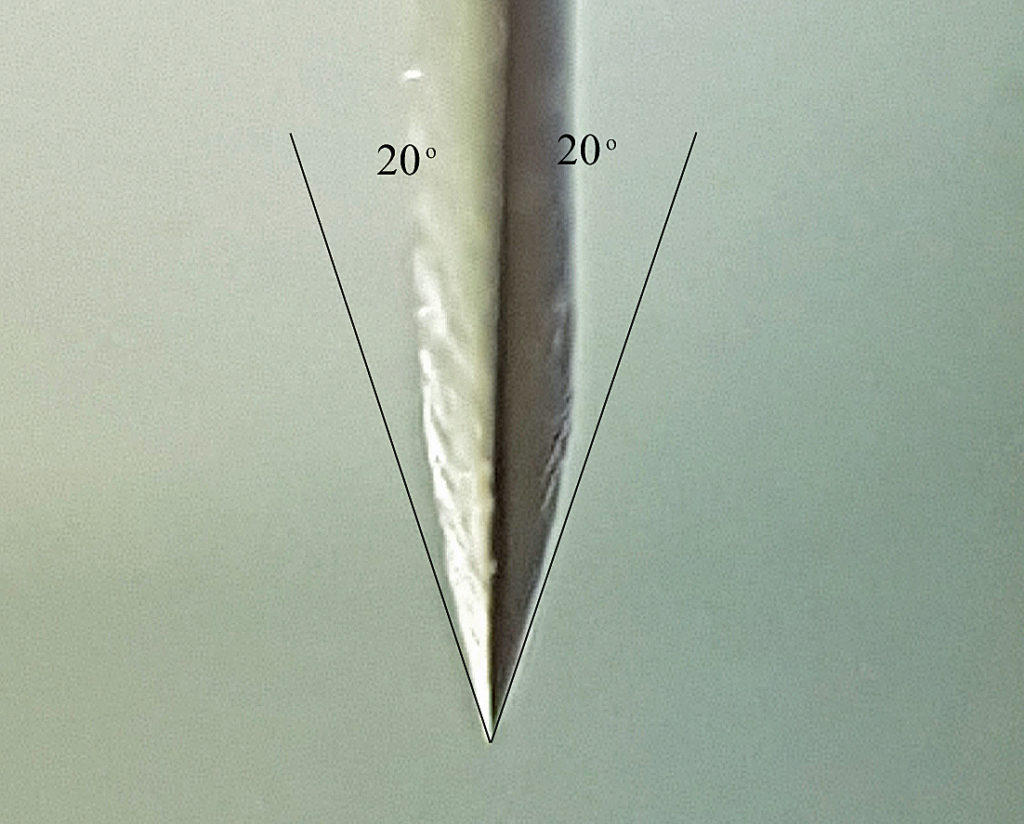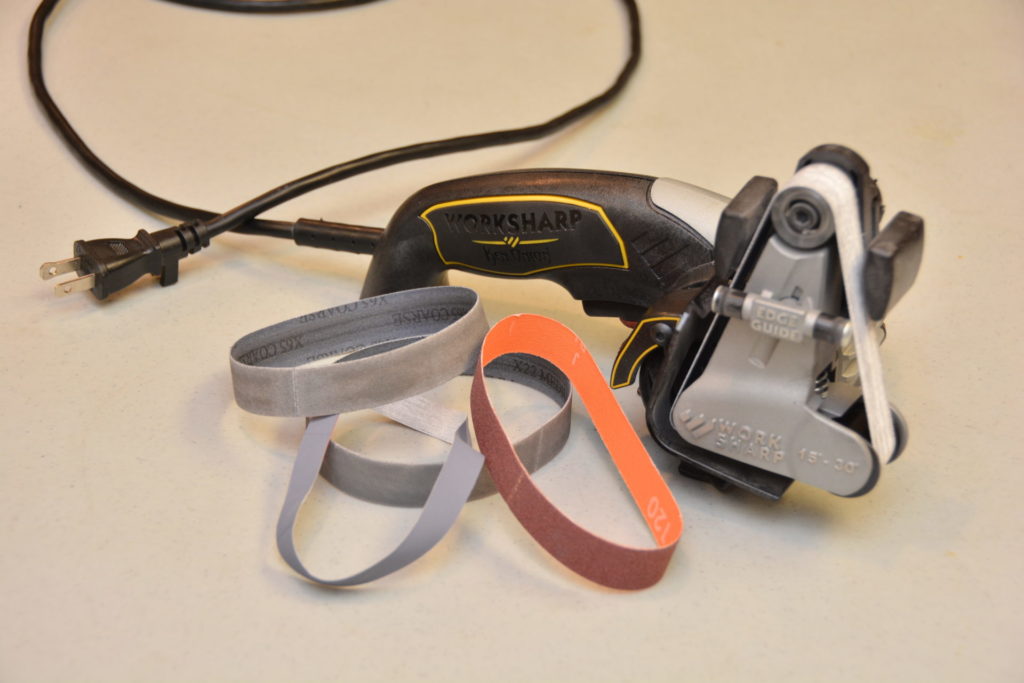I like sharpening knives. But I realize that probably makes me a little unusual. Most people think of knife sharpening as a necessary evil, but to me it borders on the therapeutic. Turning a dull knife, which is a useless tool, into a sharp knife and a valued implement is, after all, a practical achievement. But then I like handloading ammunition and spending time with a microscope too, activities which would drive a lot of people crazy.
Advertisement
But we all need sharp tools and so, whether you like sharpening knives or consider it a waste of valuable time, it’s something that must be done. Fortunately, knife sharpening isn’t the chore it used to be, nor does it take the skill it once required. New technologies have made knife sharpening easy and fast. Methodically stroking a knife blade across a whetstone just isn’t necessary anymore. But to appreciate the revolution that’s occurred in sharpening technology, it’s first necessary to understand a little about sharpening theory.

Sharpening Theory
The edge quality on any blade is always dictated by the quality of the steel and the angle at which that steel is shaped. But since a discussion about steel quality is beyond the scope of this article, I’ll just mention that, like anything else, you generally get what you pay for. For our purposes, we’ll focus on the steel’s angle.
Advertisement

There are some exceptions, but knife blades are usually ground with a bevel on each side of the edge, with the bevel angle expressed in degrees per side. So, for example, a razor may be sharpened to 12 degrees per side. This makes for an extremely sharp edge, but one with little durability because it’s thin and fragile. When it comes to conventional knives, the gentler angles, such as 20 degrees, are typically reserved for edges which need to be very sharp but aren’t subject to heavy use or abuse – think kitchen knives and filleting knives. Angles of 25 degrees are generally considered suitable for pocket knives and hunting knives. Steeper angles of 30 degrees are good for rough-use outdoor knives which may see heavy camp use, and which need a durable edge, as well as a sharp one. Axes occupy the far end of the spectrum and are usually found with angles of around 40 degrees. But all these numbers are approximate, and you can expect to see a five to 10-degree variation based on use and personal preference.
But no matter the angle, for any blade to have a good edge, the angle must be uniform and the metal forming that edge needs to be polished and smooth. To accomplish this always requires metal removal. So, as you’d expect, removing it uniformly and leaving a slick finish behind is the key to a good sharpening job.
Advertisement
Metal Removal Systems
The traditional way to remove metal during sharpening has been with a flat, rectangular stone. The knife is handheld at an estimated correct angle and the blade is pushed across the stone as if shaving a thin slice from the top of it. Of course, this system still works and it’s fun to try and sharpen a blade like the frontiersmen did. Commercial knife sharpening systems that use this method are still available, but most of them have modern refinements. These include the composition of the stone, as well as methods for holding the knife at a constant angle. Today, that “stone” is more likely to be a manufactured synthetic or ceramic product rather than a natural one. It could even be a flat surface impregnated with diamonds.
Methods for controlling the blade angle have also changed. While our ancestors did it freehand, modern systems have guides or fixtures which control the angle and make the job much easier. These guides may take the form of structures which clamp onto the blade, or just a beveled surface which gets the blade started at the correct angle.
But there are also a multitude of variations on using stones, including rotating stones spun at varying speeds. The frontier variation of this system used a circular stone up to two feet in diameter, spun at slow speed via a foot-powered treadle. Today’s variations include our shop bench grinders, handheld rotary tools and dedicated, table-mounted knife sharpeners. Just like flat stones, it’s easiest to get a sharp edge if a jig or fixture is used to hold the blade at a constant angle. Sharpening freehand takes some real skill.
The aggressive nature of spinning stones makes this a good place to talk about heat. If you’ve ever done any grinding of metal, you know that grinding generates heat quickly. And there is no greater edge-killer than heat when sharpening knives. Because, if an edge is heated beyond a certain point, it loses its temper and that portion of the blade is ruined forever. Only re-tempering the entire blade can salvage it. If you see a colour change on the metal, it’s likely the blade is now scrap. Heat is always your enemy when knife sharpening.
Another type of metal removal used in knife sharpening is via carbide scraping. In these systems, small, tungsten carbide plates are positioned to form a “V” through which a knife blade is pulled. Since carbide is much harder than knife steel, the geometry of the plates allows them to shave a sliver of steel from each side of the blade, leaving behind a properly shaped edge.
Another metal removal system which has long been used by knife makers is starting to make its way into the consumer market, and this is the use of abrasive belts. The flexible nature of belts, and their ability to remove metal quickly without generating a lot of heat in the steel, has long made them a primary method of blade shaping and sharpening for manufacturers. As you’d expect, this is not a hand-powered system, as it requires an electric motor to drive the belt. But like stones, diamonds and ceramics, belts come in different grits. Coarse grits remove metal quickly and are used for initial shaping. Medium grits finish shaping the edge and prepare it for the final polish, which is then achieved with the finer grits.
Sharpening Without Removing Metal
Everything we’ve talked about so far has involved the removal of metal to create a sharp edge. However, sometimes sharpening can be done without the removal of any metal. What we do instead is reposition it.
To grasp how this works, we first must remember that a sharp knife has a blade which bevels to a fine point. The most fragile part of the blade is obviously at the very edge of that bevel. As we’ve discussed, when that leading edge is abraded away by use, we remove metal to create it again. However, before that edge is worn away, it’s much more likely that the very tip of the bevel will be slightly bent or rolled over. When this occurs, it’s much simpler to restore sharpness by repositioning the edge. The tool used to do this is called a knife steel or a sharpening steel. When the knife’s edge is properly stroked along the length of the steel, it can restore a dull edge. However, eventually the blade will need to see a metal removal technique to return to full sharpness.
In a discussion I once had with a relative about sharpening, he declared the sharpening steel in his kitchen knife set useless because it wouldn’t remove metal. This is a common misconception, but once I explained its true purpose to him, he understood the principle behind its use. The sharpening steel is an important tool because it’s simple, never wears out, can be compact and is always faster to use than a metal removal tool.
Outdoor Sharpening Needs
As hunters and anglers, our knife needs are different from other users, and our sharpening needs are as well. The chef or butcher only uses knives in a confined work space and likely has spares, meaning blades can be sent to a commercial sharpening service. Outdoor people use their knives at home, as well as on mountainsides, along rivers and in fishing boats, so when a blade dulls, we need to take care of it ourselves.
But like everyone else, we want to sharpen blades quickly, economically and without a lot of fuss and bother. This, in my opinion, requires putting together a knife sharpening system which does the heavier grinding and edge shaping at home, but includes a complimentary portable tool for edge maintenance in the field, with the critical factor being that the two (or more) tools can all be set to produce the same angle. After all, it’s redundant to have a bench tool at home that puts a 25-degree edge on your knife, while the one in your pack or tackle box produces a 20-degree edge. Other requirements for a bench tool aren’t much different than what others need, although the ability to sharpen gut hooks is certainly welcome. Beyond that, a field sharpener needs to be lightweight, durable and useable whether our hands are bare, gloved or wet.
Options
Fortunately, it’s not necessary to spend a lot of money to set yourself up with a good knife sharpening system. For less than $100, you can get some good gear for home use and touch-up tools for the field. I’ve used the Lansky system of rod-guided stones for years and although it’s a bit slow, it has always produced a shaving sharp edge on any quality knife. Add a compact sharpening steel and a touch-up tool in your pack and you’ll be good to go.
But if you want to sharpen knives fast, you’ll have to spend a little more money. When my wife’s friends started bringing their kitchen knives over for me to sharpen, I started looking for something faster, and that led me to the Work Sharp line of tools. Specifically, their Ken Onion Edition sharpener, costing about $200 CAD. This tool is one of the new generation of consumer tools that uses belts of various grits to do the metal removal, and it’s been a game-changer in the way I sharpen knives. Getting a shaving-sharp edge is no trick at all and I can do a dozen abused knives in the time I used to do one. Knives that just need a touch-up are even faster. The belt system keeps heat at bay and the tool is flexible enough to do angles from 15 to 30 degrees, with the option to do freehand sharpening of axes and other heavy-use tools. It’ll even do gut hooks and serrated blades. An advantage of Work Sharp’s belt system is that it produces a slightly convex surface leading to the edge. This is slightly more durable than a conventional flat grind, and as a result you can use a gentler angle. As a result, I now do all my pocket and outdoor knives at 20 degrees.

To complement this powered, belt-driven system, I use a couple of compact manual tools, also made by Work Sharp, which use ceramic stones and diamond-impregnated plates for either full sharpening jobs or field touch-ups. The larger of the two, called a Guided Field Sharpener, has five sharpening surfaces of various grits for knives. But it will also do fish hooks, serrated blades and broadheads. And there’s even an integral broadhead wrench. The smaller of the two is called the Pocket Knife Sharpener and has a permanent home in my pack. It has two sharpening surfaces, a diamond plate and a ceramic rod, that can restore a knife’s edge in a matter of seconds.
Note the use of diamonds, ceramics and power-driven belts. Ours guns and fishing rods aren’t the same as those of a century ago, and sharpening systems have evolved too. Modern systems don’t require the freehand skill of the traditional whetstone because either the stone or the blade is now guided by a mechanical system. Diamonds allow us to work with harder knife steels and ceramics cut faster than stone but still leave a smooth finish. Powered belts remove metal quickly, but without overheating.
Getting the right sharpening system is just a matter of doing a little research and determining the right balance between your budget and the speed with which you want to sharpen knives and other tools. Get the best tools you can afford, and you’ll not only be able to do superior sharpening but, like me, you just might get to the point where you enjoy sharpening knives.